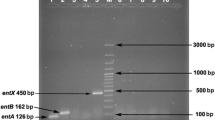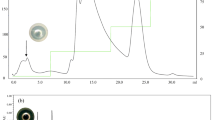Abstract
Lactococcus lactis KTH0-1S isolated from Thai traditional fermented shrimp (Kung-som) is able to produce heat-stable bacteriocin and inhibits food spoilage bacteria and food-borne pathogens. The inhibitory effect of bacteriocin remained intact after treatment with different pHs and after heating, but was sensitive to some proteolytic enzymes. Addition of bacteriocin KTH0-1S to Staphylococcus aureus cultures decreased viable cell counts by 2.8 log CFU/ml, demonstrating a bactericidal mode of action. Furthermore, the growth of S. aureus decreased significantly after 12-h co-cultivation with bacteriocinogenic strain. The molecular mass of bacteriocin KTH0-1S was found to be 3.346 kDa after ammonium sulfate precipitation, reversed phase (C8 Sep-Pak), cation-exchange chromatography, RP-HPLC on C8 column and mass spectrometry (MS/MS) analysis. Bacteriocin KTH0-1S was identified as nisin Z using PCR amplification and sequencing. The majority of tested virulence factors were absent, confirming the safety. Evidenced inhibitory effect of this strain, the absence of virulence factors creates the possibility for its application as protective culture to inhibit pathogenic bacteria in the several fermented seafood products.






Similar content being viewed by others
References
Akkaya L, Gök V, Kara R, Yaman H (2014) Enterotoxin production by Staphylococcus aureus (A, B, C, D) during the ripening of sucuk (Turkish dry-fermented sausage). CyTA J Food 12:127–133
Aunpad R, Na-Bangchang K (2007) Pumilicin 4, a novel bacteriocin with anti-MRSA and anti-VRE activity produced by newly isolated bacteria Bacillus pumilus strain WAPB4. Curr Microbiol 55:308–313
Biscola V, Todorov SD, Capuano VSC et al (2013) Isolation and characterization of a nisin-like bacteriocin produced by a Lactococcus lactis strain isolated from charqui, a Brazilian fermented, salted and dried meat product. Meat Sci 93:607–613
Brumfitt W, Salton MRJ, Hamilton-Miller JMT (2002) Nisin, alone and combined with peptidoglycan-modulating antibiotics: activity against methicillin-resistant Staphylococcus aureus and vancomycin-resistant enterococci. J Antimicrob Chemother 50:731–734
Buňková L, Buňka F, Hlobilová M et al (2009) Tyramine production of technological important strains of Lactobacillus, Lactococcus and Streptococcus. Eur Food Res Technol 229:533–538
Charlier C, Even S, Gautier M, Le Loir Y (2008) Acidification is not involved in the early inhibition of Staphylococcus aureus growth by Lactococcus lactis in milk. Int Dairy J 18:197–203
Charlier C, Cretenet M, Even S, Le Loir Y (2009) Interactions between Staphylococcus aureus and lactic acid bacteria: an old story with new perspectives. Int J Food Microbiol 131:30–39
Chatterjee C, Patton GC, Cooper L et al (2006) Engineering dehydro amino acids and thioethers into peptides using lacticin 481 synthetase. Chem Biol 13:1109–1117
Chokesajjawatee N, Pornaem S, Zo Y-G et al (2009) Incidence of Staphylococcus aureus and associated risk factors in Nham, a Thai fermented pork product. Food Microbiol 26:547–551
De Muynck C, Leroy AIJ, De Maeseneire S et al (2004) Potential of selected lactic acid bacteria to produce food compatible antifungal metabolites. Microbiol Res 159:339–346
Eaton TJ, Gasson MJ (2001) Molecular screening of Enterococcus virulence determinants and potential for genetic exchange between food and medical isolates. Appl Environ Microbiol 67:1628–1635
EFSA (2011a) Scientific opinion on the safety and efficacy of Lactococcus lactis (NCIMB 30160) as a silage additive for all species. EFSA J 9:2366
EFSA (2011b) Scientific Opinion on risk based control of biogenic amine formation in fermented foods. EFSA J 9:2393
EFSA (2012) Guidance on the assessment of bacterial susceptibility to antimicrobials of human and veterinary importance. EFSA J 10:2740
FDA, Federal Register (1988) Nisin preparation: affirmation of GRAS status as a direct human food ingredient. Fed Regist 53:11247–11251
Flasarová R, Pachlová V, Buňková L et al (2016) Biogenic amine production by Lactococcus lactis subsp. cremoris strains in the model system of Dutch-type cheese. Food Chem 194:68–75
Flórez AB, Danielsen M, Korhonen J et al (2007) Antibiotic survey of Lactococcus lactis strains to six antibiotics by Etest, and establishment of new susceptibility-resistance cut-off values. J Dairy Res 74:262–268
García-Moruno E, Carrascosa AV, Muñoz R (2005) A rapid and inexpensive method for the determination of biogenic amines from bacterial cultures by thin-layer chromatography. J Food Prot 68:625–629
Gautam N, Sharma N (2009) Bacteriocin: safest approach to preserve food products. Indian J Microbiol 49:204–211
Hanchi H, Hammami R, Kourda R et al (2014) Bacteriocinogenic properties and in vitro probiotic potential of enterococci from Tunisian dairy products. Arch Microbiol 196:331–344
Hancock REW, Rozek A (2002) Role of membranes in the activities of antimicrobial cationic peptides. FEMS Microbiol Lett 206:143–149
Huddleston JR (2014) Horizontal gene transfer in the human gastrointestinal tract: potential spread of antibiotic resistance genes. Infect Drug Resist 7:167–176
Hwanhlem N, Watthanasakphuban N, Riebroy S et al (2010) Probiotic lactic acid bacteria from Kung-Som: isolation, screening, inhibition of pathogenic bacteria. Int J Food Sci Technol 45:594–601
Kérouanton A, Hennekinne JA, Letertre C et al (2007) Characterization of Staphylococcus aureus strains associated with food poisoning outbreaks in France. Int J Food Microbiol 115:369–375
Klare I, Konstabel C, Müller-Bertling S et al (2005) Evaluation of new broth media for microdilution antibiotic susceptibility testing of Lactobacilli, Pediococci, Lactococci, and Bifidobacteria. Appl Environ Microbiol 71:8982–8986
Kuwano K, Tanaka N, Shimizu T et al (2005) Dual antibacterial mechanisms of nisin Z against Gram-positive and Gram-negative bacteria. Int J Antimicrob Agents 26:396–402
Landeta G, de las Rivas B, Carrascosa AV, Muñoz R (2007) Screening of biogenic amine production by coagulase-negative staphylococci isolated during industrial Spanish dry-cured ham processes. Meat Sci 77:556–561
Lee B, Jeong D-W, Lee J-H (2015) Genetic diversity and antibiotic resistance of Staphylococcus saprophyticus isolates from fermented foods and clinical samples. J Korean Soc Appl Biol Chem 58:659–668
Marty E, Bodenmann C, Buchs J et al (2012) Prevalence of antibiotic resistance in coagulase-negative staphylococci from spontaneously fermented meat products and safety assessment for new starters. Int J Food Microbiol 159:74–83
Mayr-Harting A, Hedges AJ, Berkeley RCW (1972) Chapter VII Methods for Studying Bacteriocins. In: Norris JR, Ribbons DW (eds) Methods in Microbiology. Academic Press, Cambridge, pp 315–422
Noonpakdee W, Santivarangkna C, Jumriangrit P et al (2003) Isolation of nisin-producing Lactococcus lactis WNC 20 strain from nham, a traditional Thai fermented sausage. Int J Food Microbiol 81:137–145
Normanno G, Firinu A, Virgilio S et al (2005) Coagulase-positive staphylococci and Staphylococcus aureus in food products marketed in Italy. Int J Food Microbiol 98:73–79
Okuda K, Zendo T, Sugimoto S et al (2013) Effects of bacteriocins on methicillin-resistant Staphylococcus aureus biofilm. Antimicrob Agents Chemother 57:5572–5579
Omar NB, Castro A, Lucas R et al (2004) Functional and safety aspects of Enterococci isolated from different Spanish foods. Syst Appl Microbiol 27:118–130
Perin LM, Miranda RO, Todorov SD et al (2014) Virulence, antibiotic resistance and biogenic amines of bacteriocinogenic lactococci and enterococci isolated from goat milk. Int J Food Microbiol 185:121–126
Piper C, Hill C, Cotter PD, Ross RP (2011) Bioengineering of a nisin A-producing Lactococcus lactis to create isogenic strains producing the natural variants nisin F, Q and Z. Microb Biotechnol 4:375–382
Poelarends GJ, Mazurkiewicz P, Konings WN (2002) Multidrug transporters and antibiotic resistance in Lactococcus lactis. Biochim Biophys Acta BBA Bioenerg 1555:1–7
Schägger H, von Jagow G (1987) Tricine-sodium dodecyl sulfate-polyacrylamide gel electrophoresis for the separation of proteins in the range from 1 to 100 kDa. Anal Biochem 166:368–379
Schillinger U, Lucke FK (1989) Antibacterial activity of Lactobacillus sake isolated from meat. Appl Environ Microbiol 55:1901–1906
Semedo T, Santos MA, Martins P, et al (2003) Comparative study using type strains and clinical food isolates to examine hemolytic activity and occurrence of the cyl operon in enterococci. J Clin Microbiol 41:2569–2576
Sequeiros C, Vallejo M, Marguet ER, Olivera NL (2010) Inhibitory activity against the fish pathogen Lactococcus garvieae produced by Lactococcus lactis TW34, a lactic acid bacterium isolated from the intestinal tract of a Patagonian fish. Arch Microbiol 192:237–245
Sequeiros C, Garcés ME, Vallejo M et al (2014) Potential aquaculture probiont Lactococcus lactis produces nisin Z and inhibits the fish pathogen Lactococcus garvieae. Arch Microbiol 197:449–458
Tabanelli G, Montanari C, Bargossi E et al (2014) Control of tyramine and histamine accumulation by lactic acid bacteria using bacteriocin forming lactococci. Int J Food Microbiol 190:14–23
Todorov SD, Dicks LMT (2005) Lactobacillus plantarum isolated from molasses produces bacteriocins active against Gram-negative bacteria. Enzyme Microb Technol 36:318–326
Toomey N, Bolton D, Fanning S (2010) Characterisation and transferability of antibiotic resistance genes from lactic acid bacteria isolated from Irish pork and beef abattoirs. Res Microbiol 161:127–135
Trias R, Badosa E, Montesinos E, Bañeras L (2008) Bioprotective Leuconostoc strains against Listeria monocytogenes in fresh fruits and vegetables. Int J Food Microbiol 127:91–98
Valenzuela AS, Ben Omar N, Abriouel H et al (2009) Virulence factors, antibiotic resistance, and bacteriocins in enterococci from artisan foods of animal origin. Food Control 20:381–385
van Reenen CA, Dicks LMT (2010) Horizontal gene transfer amongst probiotic lactic acid bacteria and other intestinal microbiota: what are the possibilities? A review. Arch Microbiol 193:157–168
Vankerckhoven V, Van Autgaerden T, Vael C et al (2004) Development of a multiplex PCR for the detection of asa1, gelE, cylA, esp, and hyl genes in enterococci and survey for virulence determinants among European hospital isolates of Enterococcus faecium. J Clin Microbiol 42:4473–4479
Vankerckhoven V, Huys G, Vancanneyt M et al (2008) Biosafety assessment of probiotics used for human consumption: recommendations from the EU-PROSAFE project. Trends Food Sci Technol 19:102–114
Veras JF, do Carmo LS, Tong LC et al (2008) A study of the enterotoxigenicity of coagulase-negative and coagulase-positive staphylococcal isolates from food poisoning outbreaks in Minas Gerais, Brazil. Int J Infect Dis 12:410–415
Wu X, Su Y-C (2014) Growth of Staphylococcus aureus and enterotoxin production in pre-cooked tuna meat. Food Control 42:63–70
Zycka-Krzesinska J, Boguslawska J, Aleksandrzak-Piekarczyk T et al (2015) Identification and characterization of tetracycline resistance in Lactococcus lactis isolated from Polish raw milk and fermented artisanal products. Int J Food Microbiol 211:134–141
Acknowledgements
This work was supported by the Higher Education Research Promotion and National Research University Project of Thailand, Office of the Higher Education Commission (AGR540556j). A part of this work was supported by the Graduate School of Prince of Songkla University and the French Bio-Asie project from Foreign Affairs Ministry of France.
Funding
This study was funded by the Higher Education Research Promotion and National Research University Project of Thailand, Office of the Higher Education Commission (AGR540556j). This study was co-funded by Graduate School of Prince of Songkla University. This study was co-funded by the French Bio-Asie project from Foreign Affairs Ministry of France.
Author information
Authors and Affiliations
Corresponding author
Ethics declarations
Conflict of interest
The authors declare that they have no conflict of interest.
Data availability
All data generated or analyzed during this study are included in this published article and its supplementary information files.
Ethical approval
This article does not contain any studies with human participants or animals performed by any of the authors.
Informed consent
Informed consent was obtained from all individual participants of this study.
Additional information
Communicated by Yusuf Akhter.
Electronic supplementary material
Below is the link to the electronic supplementary material.
Rights and permissions
About this article
Cite this article
Saelao, S., Maneerat, S., Kaewsuwan, S. et al. Inhibition of Staphylococcus aureus in vitro by bacteriocinogenic Lactococcus lactis KTH0-1S isolated from Thai fermented shrimp (Kung-som) and safety evaluation. Arch Microbiol 199, 551–562 (2017). https://doi.org/10.1007/s00203-016-1324-3
Received:
Revised:
Accepted:
Published:
Issue Date:
DOI: https://doi.org/10.1007/s00203-016-1324-3




